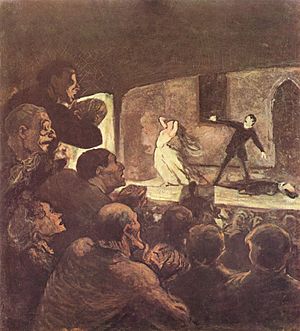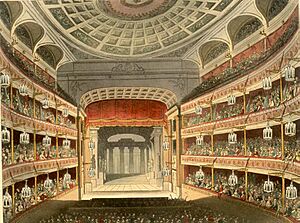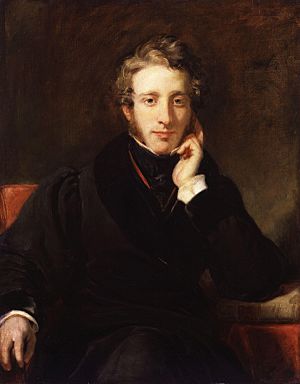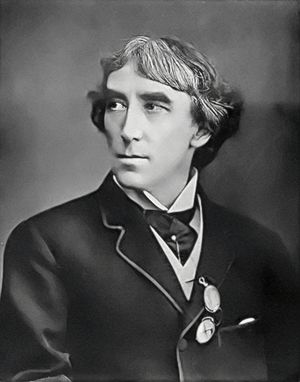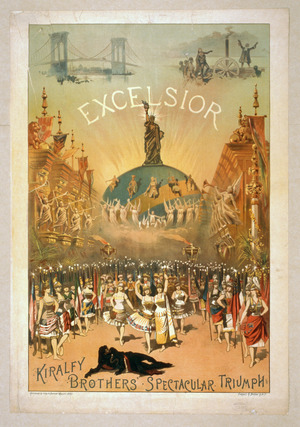Nineteenth-century theatre facts for kids
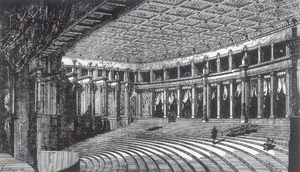
Nineteenth-century theatre was a time of big changes in plays and performances across Europe and the United States. It saw many new styles of theatre appear. These included exciting melodramas, romantic plays, and realistic stories. Famous playwrights like Richard Wagner, Gilbert and Sullivan, and Oscar Wilde created amazing works. This era also brought new ideas like Naturalism and Realism to the stage.
Contents
Exciting Melodrama Plays
After the French Revolution, melodrama became super popular in France. It quickly spread and became the most loved type of theatre in the 1800s. Melodrama has roots in ancient Greece, but the word mélodrame became common after 1800.
Playwrights like August von Kotzebue and René Charles Guilbert de Pixérécourt made melodrama famous. Kotzebue was very popular, writing over 215 plays. His play The Stranger (1789) is a classic example of melodrama. Even when governments tried to control theatre, melodrama drew huge crowds.
Melodrama plays used lots of special effects and emotional acting. Stage technology improved, making shows grand and spectacular. This type of theatre also changed a lot to fit new audiences and ideas. This helped it stay popular for the whole century.
One expert, David Grimsted, said that melodrama might have seemed simple. But it was popular because it took the lives of everyday people seriously. It showed that good would always win, and people could improve.
In Paris, many melodrama theatres were on the famous Boulevard du Crime. Sadly, most of these theatres were torn down in 1862. This happened during the big rebuilding of Paris.
By the end of the 1800s, melodrama mostly meant spoken words, often poetry, with music. It wasn't always sung, but it had a dramatic story. This type of entertainment was not always seen as important.
Romanticism in Germany and France
In Germany, theatre started to focus on historical accuracy. This meant costumes and sets looked more real for the time period. New theatre buildings were also designed. German writers were very interested in their past and their national pride.
Plays by Gotthold Ephraim Lessing, Johann Wolfgang von Goethe, and Friedrich Schiller were important. They showed that feelings and instincts could guide people to do good. Artists like August Wilhelm Schlegel and Ludwig Tieck were deeply involved in theatre. They believed art could show important truths.
Later, Romanticism came to France. Playwrights like Victor Hugo, Alexandre Dumas, and Alfred de Musset wrote romantic plays.
In the 1830s, French theatre fought against old rules. The Comédie-Française theatre liked traditional, serious plays. This led to a big clash when Victor Hugo's play Hernani opened in 1830.
Many conservatives and censors were in the audience. They booed the show because it broke old theatre rules. But Hugo had gathered a group of young, radical writers to support his play. The opening night turned into a riot. This event showed that France was ready to move past old traditions. It was a victory for Romanticism.
However, by the 1840s, people in France were less excited about Romantic drama. A new "Theatre of Common Sense" took its place.
The "Well-Made Play"
In France, a style called the "well-made play" became very popular. Eugene Scribe (1791–1861) created this style in 1825. These plays had a tight plot and a big exciting moment near the end.
The story often relied on a secret piece of information. Some characters knew it, but others (and the audience) did not. A common trick was letters or papers falling into the wrong hands. This would create plot twists and exciting moments. The suspense would build to a climax where the hero would win.
Scribe wrote over 400 plays in this style. He even had a "literary factory" with different writers for stories, dialogue, and jokes. Even though he was very popular, some critics didn't like his plays. They wondered how he could be so successful without poetry or deep meaning.
Other playwrights like Alexandre Dumas, fils and Victorien Sardou used this structure. Sardou was one of the most popular playwrights from 1860 to 1900. He used the "well-made play" for all kinds of shows. In Britain, writers like Wilkie Collins and Henry Arthur Jones also used this style. Collins said a well-made play should "Make ’em laugh; make ’em weep; make ’em wait."
Theatre in Britain
In the early 1800s, a law called the Licensing Act limited plays to only two London theatres in winter. These were Drury Lane and Covent Garden. These theatres were huge, with royal boxes, big galleries, and a pit where people could move around.
A famous event showing theatre's popularity was the Old Price riots of 1809. After Covent Garden burned down, the manager, John Philip Kemble, raised ticket prices. Audiences were very angry. They felt they were losing access to a national meeting place. This led to three months of riots. Finally, Kemble had to apologize and lower prices.
To get around the rules, other theatres put on plays with music and comedy skits. This led to the creation of the modern West End. Outside London, places like Astley's Amphitheatre also operated freely. The growing popularity of these shows made the old law hard to enforce. The rules started to blur until the Licensing Act was removed in 1843.
Parliament hoped this would make audiences more polite and plays better. Instead, it led to many new Music halls, comedies, and exciting melodramas.
Percy Bysshe Shelley and Lord Byron were important writers of plays. Shakespeare was also very popular. His plays started to be performed closer to their original versions. Earlier, they had been heavily changed. Thomas Holcroft's A Tale of Mystery was the first English melodrama.
Later, writers like Pierce Egan and Dion Boucicault wrote more modern and rural stories. James Sheridan Knowles and Edward Bulwer-Lytton created "gentlemanly" dramas. These helped theatre regain respect among the upper class.
Throughout the century, theatres were run by actor-managers. These were actors who also managed the theatre and often played the main roles. Henry Irving, Charles Kean, and Herbert Beerbohm Tree were famous examples. Irving ran the Lyceum Theatre for almost 30 years. He was a huge star. When he died, even King Edward VII and Theodore Roosevelt sent their condolences.
Shakespeare's plays were often the most popular. They gave leading actors great chances to shine. Sometimes, the stage spectacle was more important than the play itself. But these managers also made important changes. For example, William Charles Macready was the first to have proper rehearsals. Before this, lead actors rarely practiced with the rest of the cast.
Melodramas, light comedies, operas, and Shakespeare plays stayed popular. So did pantomimes and French comedies. From the 1860s, French operettas also became a hit. James Planché and Dion Boucicault were very successful playwrights. Boucicault used new scientific inventions in his plots. His play London Assurance (1841) was a popular comedy.
In 1871, producer John Hollingshead brought together writer W.S. Gilbert and composer Arthur Sullivan. They created Christmas entertainment. This led to one of theatre's greatest duos. Their 14 comic operas, like H.M.S. Pinafore (1878) and The Mikado (1885), were huge successes. They greatly influenced 20th-century musical theatre.
Better street lighting and transportation in London and New York helped too. This led to a boom in theatre building at the end of the century. In the 1890s, comedies by Oscar Wilde and George Bernard Shaw were very popular. They offered clever comments on society.
Theatre in the United States
In the United States, Philadelphia was the main theatre city until the 1820s. The Chestnut Street Theatre was founded there. It had great actors like William Warren and Thomas Abthorpe Cooper. After the American Revolution, many Americans wanted their own plays. Writers like Royall Tyler and William Dunlap started to create American drama. Playwrights were often not paid much, so it was cheaper to adapt foreign plays.
William Dunlap is called the "Father of the American Drama." He managed the John Street Theatre and Park Theatre in New York City. He brought plays and theatre ideas from London to America. Dunlap adapted many French and German melodramas. But he also wrote 29 original plays. These included The Father (1789) and André (1798).
From 1820 to 1830, more people wanted entertainment. New theatres were built in New York, Philadelphia, Boston, and Washington. Philadelphia was still a major theatre center. Plays would often open in Baltimore before moving to Philadelphia. Then they would go to Washington or Alexandria for the summer.
However, many theatre companies went bankrupt. Also, famous "star system" performers like Clara Fisher came to America. Because of this, New York became the most important city for American theatre.
In the 1830s, Romanticism grew in Europe and America. Writers like Robert Montgomery Bird became famous. Romanticism focused on big truths and national pride. This fit well with America's growing national identity. Bird's play The Gladiator was a huge hit in 1831. It was even performed in London.
The play was about a slave uprising in Ancient Rome. It hinted at problems with slavery in America. Edwin Forrest played Spartacus in over a thousand performances worldwide. Bird and Forrest worked together on more plays. But they later had disagreements about money.
Minstrel shows started in the 1830s as short comedies. By 1848, these shows were a national art form. They made formal art like opera popular for everyone. Each show had funny skits, variety acts, dancing, and music. Performers were usually white people in blackface makeup. They played characters that mocked black people. Minstrel shows had characters like the slave and the dandy.
Audiences loved star actors, like today's celebrities. But audiences also used theatres to show their feelings. They would cheer or boo actors and even other audience members. Theatre riots were common in New York. The Astor Place riot in 1849 was caused by a fight between American actor Edwin Forrest and English actor William Charles Macready. This riot led to many deaths and injuries.
Before the Civil War, many political plays were staged. As America expanded west, plays romanticized Native Americans. Titles included Pocahontas and Metamora or the Last of the Wampanoags. About fifty such plays were produced between 1825 and 1860. Some were funny plays that made fun of the "noble savage."
Playwrights also wrote short comedies about current events. For example, Removing the Deposits (1835) was a comedy about Andrew Jackson's fight with the banks.
In 1852, Harriet Beecher Stowe wrote the anti-slavery novel Uncle Tom's Cabin. Because there were no strong copyright laws, it was quickly turned into plays. At the National Theatre in New York, it was a huge success. It ran for over two hundred performances.
Minstrel shows also reacted to Uncle Tom's Cabin. They often changed the story to be more cheerful. Characters like Uncle Tom were sometimes shown as silly. Special groups called Tommer companies performed these funny versions. They competed with minstrel shows for a while.
After the Civil War, American theatre had many types of shows. These included melodramas, minstrel shows, comedies, and circuses. Vaudeville and burlesque were also popular. Many American playwrights felt that American plays were not good enough.
However, cities grew quickly with new people coming in. New technology and transportation also changed American theatre. Irish American performers started to become successful in Boston. These included Lawrence Barrett and James O'Neill. Irish playwrights like Augustin Daly also became important.
In 1883, the Kiralfy brothers met Thomas Edison. They wanted to use his electric light bulb in a ballet called Excelsior. Edison saw the potential to show off his invention. They designed a finale with over five hundred light bulbs on costumes and scenery. When the show opened, it was an instant hit. This was the start of electric lighting in the theatre. It changed stage lighting and set design forever.
The Gilded Age was also a golden age for touring shows. New York City was the main theatre hub. But across the country, many theatres supported a huge industry. Famous stars, small groups, minstrel shows, and circuses traveled everywhere. For example, in 1895, the Burt Theatre in Toledo had 45,000 people per month. They saw 64 different plays.
Between 1880 and 1910, about 250-300 shows toured the country each year. Theatre owners started to expand their businesses. B.F. Keith and Edward F. Albee built a theatre empire. It included over seven hundred theatres. This led to the creation of the Theatrical Syndicate in 1896.
New York City's theatre scene grew around Union Square in the 1870s. It became the main theatre center. The Theater District slowly moved north. It finally reached midtown Manhattan at the end of the century.
On the musical stage, Harrigan and Hart created funny musical plays from the 1870s. But London shows became very popular. These included Victorian burlesque and Gilbert and Sullivan operas. Later, Edwardian musical comedies became popular.
Meiningen Ensemble and Richard Wagner
In Germany, theatre wasn't doing well until the 1890s. The main playwrights were Otto Ludwig and Gustav Freytag. But plays by Shakespeare, Lessing, Goethe, and Schiller were still performed a lot.
The most important theatre group in late 19th-century Germany was the Meiningen Ensemble. It was led by Georg II, Duke of Saxe-Meiningen and Ludwig Chronegk. Their shows were known for being very historically accurate. They used detailed, real costumes and furniture. This was new in Europe at the time.
The Meiningen Ensemble helped start a new movement. It focused on making all parts of a production work together. This was called "unified production." It also led to the rise of the director as the main artist.
The Meiningen Ensemble toured Europe from 1874 to 1890. They were incredibly successful. Audiences were tired of simple entertainment. They wanted more creative and thoughtful shows. The Ensemble provided this. They were pioneers of the "art-theatre" movement.
Richard Wagner (1813–1883) didn't like the trend toward realism. He believed playwrights should create myths. They should show an ideal world through people's feelings. Wagner used music to control performers. The music's melody and speed gave him more control than with spoken plays.
Like the Meiningen Ensemble, Wagner believed the writer-composer should oversee everything. This was to unite all parts into a "master art work." Wagner also designed a new type of auditorium. It had no side boxes or pits. Instead, it was fan-shaped with 1,745 seats. This meant every seat had a full view of the stage.
Rise of Realism in Russia
In Russia, Aleksandr Griboyedov, Alexander Pushkin, and Nikolai Polevoy were important playwrights. Like other places, Russia had many melodramas and musical shows. But more realistic drama started to appear. This was seen in plays by Nikolai Gogol and the acting of Mikhail Shchepkin.
The Russian theatre grew a lot under government watch. Prince Alexander Shakhovskoy opened state theatres and training schools. He tried to improve Russian productions after visiting Paris. He also set rules for theatre groups that lasted until 1917.
Realism started earlier in Russia than in other parts of Europe. It was also more direct. Plays by Ivan Turgenev used small details to show inner feelings. Aleksandr Ostrovsky was Russia's first professional playwright. Aleksey Pisemsky's A Bitter Fate (1859) was an early example of Naturalism. Leo Tolstoy's The Power of Darkness (1886) is a powerful naturalistic play. This tradition of psychological realism led to the Moscow Art Theatre. It was founded by Konstantin Stanislavski and Vladimir Nemirovich-Danchenko.
Ostrovsky is often seen as the creator of a unique Russian drama. His plays like Enough Stupidity in Every Wise Man (1868) and The Storm (1859) showed the lives of the middle class. Other important Russian playwrights were Alexander Sukhovo-Kobylin and Mikhail Saltykov-Shchedrin.
Naturalism and Realism in Theatre
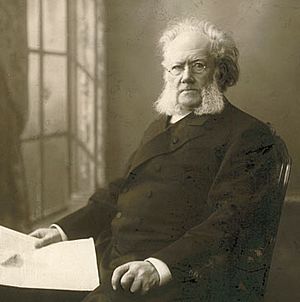
Naturalism was a theatre movement inspired by Charles Darwin's The Origin of Species (1859). It also came from the social and economic conditions of the time. Émile Zola was its main supporter. In his essay "Naturalism in the Theatre" (1881), he said that poetry is everywhere. He believed there was more poetry in a normal person's apartment than in old palaces.
It was hard to find playwrights who could write true naturalist dramas. André Antoine started his Théâtre Libre in the 1880s. It was only for members, so it didn't have to follow censorship rules. Zola approved of Antoine's work. Antoine started staging Naturalistic and other realistic plays.
Antoine was special in his set design. He built sets with a "fourth wall" intact. This meant the audience felt like they were looking into a real room. He would only decide which wall to remove later. Important French playwrights like Georges Porto-Riche and Eugène Brieux had their first plays performed by Antoine.
The work of Henry Arthur Jones and Arthur Wing Pinero brought new ideas to the English stage. But the most important drama came from the playwright Henrik Ibsen.
Ibsen was born in Norway in 1828. He wrote 25 plays. His most famous ones are A Doll's House (1879), Ghosts (1881), and Hedda Gabler (1890). A Doll's House and Ghosts shocked many people. Nora leaving her family in A Doll's House was seen as an attack on home life. Ghosts was considered very offensive.
Ibsen improved the "well-made play" style to make it more realistic. He gave other realistic writers a model to follow. His plays Rosmersholm (1886) and When We Dead Awaken (1899) hinted at mysterious forces. This idea became a big theme in symbolism.
After Ibsen, British theatre became more lively. This was thanks to the plays of George Bernard Shaw and Oscar Wilde. Unlike many serious plays of their time, Shaw and Wilde mostly wrote comedies.
Technology Changes in Theatre
Stage Lighting Advances
In the 1700s, theatres used candles and oil lamps. These just lit up the stage so the audience could see. But this changed in the early 1800s. Gas lighting was slowly adopted by major theatres in the 1810s and 1820s. It lit both the audience area and the stage.
Gas lighting completely changed stage lighting. It gave a more natural and better light for the actors and sets. At first, gas lights couldn't be controlled. But this soon changed. In Britain, theatres in London started using limelight in the late 1830s. In Paris, the electric carbon arc lamp appeared in the 1840s. Both of these lights could be moved and focused. For the first time, theatre could shine a spotlight on specific performers.
From the 1880s, theatres slowly started using electricity. The Savoy Theatre in London was the first theatre in the world to have a fully electric lighting system in 1881. Richard D'Oyly Carte, who built the Savoy, explained why he used electric light. He said gas lights made the air bad and hot. Electric lamps used no oxygen and caused no heat. The arrival of electric light happened at the same time as realism in theatre. New lighting encouraged more realistic sets and a more subtle, realistic acting style.
Scenic Design Changes
A big change in scenery was moving from flat, two-dimensional backdrops to three-dimensional sets. Before, scenery was just a painted background. It didn't feel like a real place for the play to happen. This changed in the first half of the century when 3D sets were introduced.
This, along with changes in how audiences and stages worked, made theatre more realistic. Hidden scene changes also became possible. Theatre became more about showing a real world, not just presenting a show. It invited the audience to feel like they were transported to another place. The early 1800s also saw the "moving panorama." This was a long painted cloth that unrolled across the stage. It created the illusion of movement and changing locations.
See also
- History of theatre
- Nineteenth-century theatrical scenery
- Twentieth-century theatre


